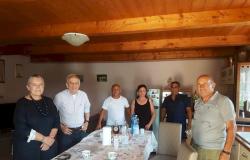Describing the centuries-old Jewish presence on the Italian peninsula is not easy. The discussion becomes even more complex if the events of the twentieth century are narrated, a century full of events that have indelibly marked our history. The exhibition “Jews in the Italian Twentieth Century” was born from this necessity and opened at the National Museum of Italian Judaism and the Shoah – MEIS in Ferrara and can be visited from 29 March to 6 October 2024.
The exhibition itinerary, curated by the historian Mario Toscano and the publisher and scientific popularizer Vittorio Bo, retraces one hundred years of Italian history through documents, images and works of art, placing the concept of citizenship at the center and exploring the challenges, the pain and the rebirth of Italy’s Jews during a century full of sociopolitical changes. “With this exhibition we achieve the ambitious goal of recounting over 2000 years of uninterrupted Jewish presence in our peninsula and a new chapter opens: describing contemporaneity with incisiveness and coherence, who Italian Jews are today, what values they share, what hopes nourish for the future – Amedeo Spagnoletto, Director of MEIS, explains to Shalom –. A difficult challenge, to be pursued with coherence, but also with enthusiasm, which fortunately we do not lack. A new page to tell with everyone’s participation.”
This journey through history begins at the end of the 19th century, at the dawn of a new and recently united Italy, in which the Jews now out of the ghettos – which had suffocated their civil liberties for a long time – finally acquired the status of citizens with full rights. A new period, full of hope for the future, characterized by important political figures such as Giuseppe Ottolenghi and Luigi Luzzatti together with individual families whose stories and traditions echo a page of happy history of the Jews of Italy.
“This exhibition concludes a cycle for MEIS. In fact, together with Vittorio Bo, co-curator of the exhibition, we decided to create a path that put the theme of citizenship at the center and at the same time reflected on the entire twentieth century in its diversifications” explains co-curator Mario Toscano to Shalom.
We then move on to the terrible twenty years of fascism, represented in the exhibition through the crucial stages of one of the darkest pages in the country’s history.
“Fascism has been divided into different parts which, in turn, have a different impact on Jewish citizens. The first is the one that embraces the 1920s, therefore the construction of the fascist state and the end of all freedoms: of association, of the press, of opinion and then of religion, which had been a key principle of the liberal state – says Prof Toscano – Then we have a subsequent part that reaches up to the mid-thirties in which the first signs of racism and anti-Semitism begin. In 1938 fascism would then definitively adopt anti-Semitic politics. From here, two phases begin, the one from 1938 to 1943, in which, after the crisis of 8 September, with the German occupation, the picture changes radically. This historical phase ends when the various parts of Italy are liberated on 25 July 1945” continues Prof. Toscano.

From the black page of the occupation of Rome, which was followed by the deportations to the Nazi extermination camps, we move on to the drama of the post-Shoah period, the processing of the trauma and the post-war reconstruction. “At this point, there are more than fifty years left to reach the end of the century, made up of important passages: these are the years of republican Italy, of the Constitution, of the repeal of the racial laws, of the alyah Bet and of the reconstruction of the Communities Italian. Very dense years in which the reintegration of Italian Jewish citizens with full rights into the State was achieved little by little, with various stages” continues Toscano.
The exhibition develops through an immersive journey into the dark pages of the twentieth century, without giving up on recounting that never-healed wound that was the attack on the synagogue in Rome on 9 October 1982. Rooms full of history, which follow one another in the seven sections of the exhibition, reconstructing a picture full of food for thought on the past and present of Italian Jews.
Awarded the Medal of the President of the Republic, the exhibition was created with the support and patronage of the Ministry of Culture, the Emilia-Romagna Region, the Municipality of Ferrara and the Union of Italian Jewish Communities and the patronage of the Jewish Community of Ferrara . It was supported by Intesa Sanpaolo and sponsored by the Guglielmo De Lévy Foundation, Avis Provinciale e Comunale Ferrara, TPER, Gruppo Hera, Coop Alleanza 3.0 and Fondazione Bottari Lattes.









